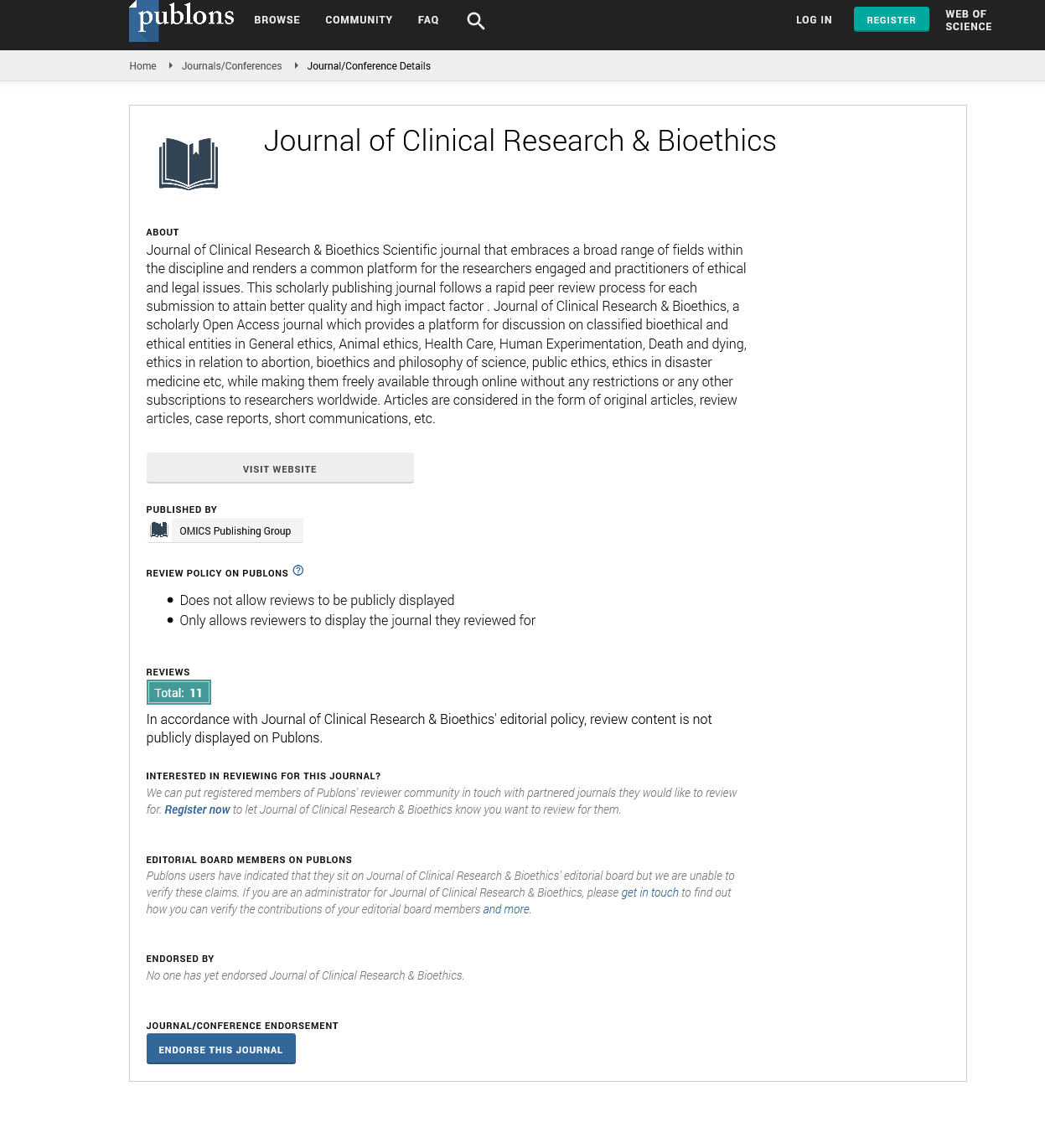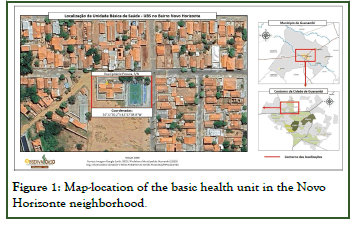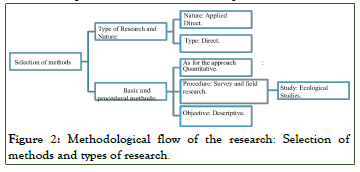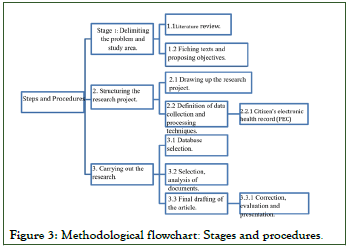Indexed In
- Open J Gate
- Genamics JournalSeek
- JournalTOCs
- RefSeek
- Hamdard University
- EBSCO A-Z
- OCLC- WorldCat
- Publons
- Geneva Foundation for Medical Education and Research
- Google Scholar
Useful Links
Share This Page
Journal Flyer

Open Access Journals
- Agri and Aquaculture
- Biochemistry
- Bioinformatics & Systems Biology
- Business & Management
- Chemistry
- Clinical Sciences
- Engineering
- Food & Nutrition
- General Science
- Genetics & Molecular Biology
- Immunology & Microbiology
- Medical Sciences
- Neuroscience & Psychology
- Nursing & Health Care
- Pharmaceutical Sciences
Research Article - (2025) Volume 16, Issue 1
Neglected Venereal Infections: Analysis in the Context of Primary Care in a Community in the Municipality of Guanambi in the Course of 2023 Year
Eisler Emanuelle Gomes Pires1, Emanuele Prado Martins1, Giovana Souza Batista1, Amanda de Oliveira Araujo1, Joao Augusto Saraiva Silva1, Julia Sami Melo e Souza1, Marjore Porto Fraga1, Victor Gabriel Soares1 and Felipe Teixeira Dias2*2Department of Medicine, FIP Guanambi Standard Integrated Colleges, Guanambi, Brazil
Received: 31-Jan-2024, Manuscript No. JCRB-24-24750; Editor assigned: 02-Feb-2024, Pre QC No. JCRB-24-24750 (PQ); Reviewed: 05-Feb-2024, QC No. JCRB-24-24750; Revised: 01-Apr-2025, Manuscript No. JCRB-24-24750 (R); Published: 08-Apr-2025, DOI: 10.35248/2155-9627.25.16.510
Abstract
This article analyzed Sexually Transmitted Infections (STIs) in the context of primary care in the Novo Horizonte neighborhood in Guanambi-BA, the risk factors and consequences for health and well-being. The objective was to analyze the occurrence of neglected venereal infections in the context of primary care in the Novo Horizonte neighborhood in the municipality of Guanambi over the course of 2023. The study adopts a deductive approach, using quantitative methods to assess the impact on communities. For the formulation and design of the research, a meticulous evaluation of the complexities underlying the data submitted to the electronic citizen record (PEC) was carried out with an emphasis on data from the Novo Horizonte neighborhood community. The results showed that STIs are a public health problem that affects thousands of people throughout Brazil and a significant part of the population of Guanambi-BA. The research highlights the importance of continuous epidemiological surveillance and the implementation of accessible prevention and treatment strategies. It is hoped that this research will provide input for further research on the subject.
Keywords
Infections; Primary care; Municipality; Guanambi
Introduction
Sexually Transmitted Infections (STIs) are a group of infectious diseases that are spread mainly through unprotected sexual intercourse and are a major public health challenge worldwide. According to the World Health Organization (WHO), STIs affect millions of people every year, with consequences ranging from discomfort and immediate health complications to serious risks such as infertility, cancer and an increased risk of contracting HIV [1].
In this context, STIs represent a constant challenge for professionals working in Primary Health Care (PHC). This is due to the need for early diagnosis, effective treatment and above all, the promotion of safe sex practices to prevent the spread of these infections [2]. Thus, primary care is the fundamental pillar for the control and effective management of STIs, as it represents the first point of contact between individuals and the health system [3].
It is therefore important to note that, despite advances in medicine and prevention strategies, venereal infections often affect marginalized populations, including those with limited access to health services and educational information on sexual health [4]. This creates significant inequalities in access to treatment and prevention of these infections, exacerbating disparities in access to healthcare. Therefore, it is evident that seeking information about neglected venereal diseases is fundamental to understanding their significant impact on public health and the quality of life of affected populations [5].
Primary care is the gateway to the Unified Health System (SUS) and plays an important role in ensuring access to quality healthcare and services for the population of the territory where it is located [6]. According to the Ministry of Health, neglected venereal infections are considered a public health problem with the greatest impact on the public health system and people's quality of life [7].
This topic was chosen for this research, since by dealing with these infections, the research will help to provide a more complete picture of sexually transmitted infections and will allow for more effective prevention, diagnosis and treatment strategies.
As part of the medical course, students study the prevalence and distribution of STIs on a local and global level, including statistics, risk factors and the groups most affected. According to the National Health Survey (PNS), released in 2021, around 1 million people said they had been diagnosed with an STI over 12 months, which corresponds to 0.6% of the population aged 18 or over [8]. The figures draw attention because they reflect unprotected sexual relations that facilitate the transmission of diseases, affecting young people who feel increasingly confident in this type of relationship. However, young people's adherence to events on sexually transmitted infections is key to raising awareness and preventing these diseases, so the Ministry of Education, together with the School Health Program (PSE), plans to work on sexual and reproductive health and STI prevention in the classroom.
In this sense, there is a group of neglected venereal diseases that receive little attention in terms of research and health education actions, making it relevant in the academic context as it provides students and researchers with an expansion of the existing knowledge base.
Research into neglected venereal diseases such as herpes, syphilis and HIV infection, among others, is essential for improving public health in a comprehensive way. Although these diseases do not receive the attention they deserve, they affect many people, many of whom may be in vulnerable situations. Therefore, understanding the epidemiology, risk factors and transmission of these diseases is fundamental to promoting effective health education actions that have an impact on the community's reality.
Objective: To investigate the prevalence, risk factors and gaps in the detection and management of sexually transmitted infections in primary care, with the aim of contributing to the improvement of prevention and control strategies in a community in the municipality of Guanambi throughout 2023.
Materials and Methods
The classification of this research is of the type of deductive reasoning that seeks to analyze the context of sexually transmitted infections in primary care, in which it emerges from a research of an applied nature, since it is proposed to analyze the rates of STIs in the basic health unit of the Novo horizonte neighborhood in the municipality of Guanambi between the months of January and September 2023. According to the Ministry of Health, "The terminology Sexually Transmitted Infections (STI) is now adopted to replace the expression Sexually Transmitted Diseases (STD), because it highlights the possibility of a person having and transmitting an infection, even without signs and symptoms" [9].
Thus, in order to outline the phases and protocols guiding this project, it was imperative to select the methods and guidelines that would enable the formulation of a process capable of answering the central question. In this context, it became essential to explore the interpretations and principles that underpin the notion of STI rates from an external perspective related to the analysis of sexually transmitted infections in the context of primary care.
In addition, to delimit the data on STIs between January and September 2023, we used the data provided by the Basic Health Unit of the Novo Horizonte neighborhood. Thus, based on Resolution 510/2016, as the project is a database study whose information is aggregated without the possibility of individual identification, it is not necessary to be approved by a research ethics committee; however, the ethical and moral precepts of a community intervention were respected [10].
Study area
The study area selected is the Novo Horizonte neighborhood located in the city of Guanambi, a city in the Southwest region of Bahia. The choice of this study area was based on convenience sampling, since it is both a low-development locality and the home of FIPGUANAMBI, the higher education institution that will support this research.
The region has a total of 87,817 inhabitants, a density of 69.02/km2, a GDP of R$17,452.14 and Caatinga vegetation (Figure 1).
Figure 1: Map-location of the basic health unit in the Novo Horizonte neighborhood.
Methods used
For the formulation and planning of this research project, the deductive method was carefully chosen as the starting point for the research. The established choice of this method stems from a meticulous evaluation of the complexities underlying the data presented in the electronic citizen record (PEC), where a notable layer was found between the probabilities of occurrence verified according to the chosen theme.
In this context, in order to enrich the logical structuring of the chosen method and delineate the nature of the research more precisely, it was decided to adopt a quantitative approach. This approach is relevant in the context of this investigation, since the degree of planning among the primary care team at the basic health unit and the resulting impact on the health and wellbeing of communities should also be assessed [11]. Figure 2 shows the schematization of the methods, as procedures, objectives, study and their respective data collection techniques.
Figure 2: Methodological flow of the research: Selection of methods and types of research.
Figure 2 shows the types of research and their respective methods, which will be needed to systematize the research in question. Thus, it can be inferred from Figure 2 that the procedural method used was survey and field research, due to the way the research was prepared and constructed, i.e. using the PEC data provided by the Basic Health Unit in the Novo Horizonte neighborhood, which shows the assistance provided to improve the community's well-being. In addition, the main purpose of the method is exploration, as this is an extremely relevant approach. This method proposes an analysis according to the context of primary care in relation to STI cases.
Steps and procedures
In order to carry out the research, it was necessary to define 3 stages with the definition of 7 procedures within these stages, with the aim of meeting the specific objectives of this research (Figure 3). Figure 1 shows the organization and flowchart of the established stages and their respective procedures and materials used.
Figure 3: Methodological flowchart: Stages and procedures.
Bibliography: Articles were selected in Portuguese, peerreviewed, between the years 2019 and 2023, on the topics of sexually transmitted diseases, STIs and STDs, which were correlated to the theme of this research, on venereal diseases. In addition, the following keywords were defined primary carepublic health-sexually transmitted infections-in order to guide searches in databases and indexers.
Results and Discussions
Venereal diseases, currently known as sexually transmitted infections or STIs, are diseases transmitted through unprotected sexual intercourse, which can be oral, vaginal or anal [12]. Even if there are no obvious signs or symptoms of the disease, transmission to a sexual partner is possible. This type of infection should preferably be identified in the early stages, so that treatment can be started right away and the chances of a cure increased [13].
STIs are a wide range of clinical syndromes and infections caused by viruses, bacteria and other microorganisms [14]. In this way, they can be acquired and transmitted through sexual activity including the involvement of bodily fluids such as blood, semen and vaginal secretions. In addition, transmission occurs through other infection profiles such as vertical transmission, which occurs during pregnancy, childbirth or breastfeeding [15].
In light of this, a partnership between the Ministry of Health and the Brazilian Institute of Geography and Statistics (IBGE) provides valuable information for caring for the population. Modules from the National Health Survey (PNS) 2019 show that approximately 1 million people reported having a medical diagnosis of sexually transmitted infection during the year, which corresponds to 0.6% of the population aged 18 or over [16]. In parallel to this, we have data from the World Health Organization, in which more than one million people acquire an STI every day.
In addition, the Ministry of Health shows that 10.3 million Brazilians have already had some sign or symptom of STIs, such as syphilis, HPV (Human Papillomavirus), gonorrhea and genital herpes. In total, there are 6.6 million men and 3.7 million women [17].
Given this scenario, Epidemiological Surveillance (ES) aims to permanently observe and analyze the epidemiological situation of STIs, HIV/AIDS, viral hepatitis and co-infections, articulating a set of actions aimed at health promotion, prevention and recovery. It also aims to provide relevant information for the formulation, management and evaluation of public policies and actions of strategic importance. In short, information for action [18].
Thus, the strategies and recommendations related to epidemiological surveillance of STIs, HIV/AIDS and viral hepatitis are systematized in the health surveillance guide (GVS). The GVS is more than an information tool; it aims to disseminate procedures relating to flows, deadlines, instruments, definitions of suspected and confirmed cases, the functioning of health information systems, conduct, control measures and other technical guidelines for the operationalization of the national health surveillance system [19].
STIs are among the health problems with the greatest impact on public health systems and on people's quality of life in Brazil and around the world. They are caused by viruses, bacteria or other microorganisms that are sexually transmitted, including genital herpes, syphilis, gonorrhea, HPV, HIV/AIDS, chlamydia, trichomoniasis, as well as viral hepatitis B and C.
Depending on the disease, they can develop into serious complications. An important scenario is adolescence, an extremely important phase, known by many to be a period of uncertainty, transition and also a period of potential conflicts and crises, but a period of seeking freedom. It's worth pointing out that this period is a decisive moment and the most important in human sexual development, as it is during this time that sexuality becomes genitalized, with intense biopsychosocial transformations taking place that give adolescents the chance to rethink previous identifications and acquisitions, making them ready for an active sex life.
In view of the above, the 2019 National Health Policy provides data on this STI scenario: Among individuals who are in the early stages of active sexual life, in the 12 months prior to the data survey, only 22.8% (or 26.6 million people) used condoms in all sexual relations. 17.1% of those interviewed said they used them sometimes and 59.0% not at all.
The analysis reveals a notable lack of knowledge about sexually transmitted infections among the population. The lack of substantial understanding about STIs highlights a significant gap in awareness. Additionally, it was found that the local basic health unit does not adequately address this critical issue, highlighting the lack of effective educational initiatives. The absence of information about STIs highlights the urgent need to implement educational programs aimed at raising awareness, promoting education in the community and encouraging the search for preventive care. This proactive approach is crucial to tackling the public health problem posed by STIs and can contribute significantly to reducing the incidence of these infections.
Thus, these neglected venereal infections do not receive due attention and investment in research and prevention. Neglect of these STIs is often due to lack of awareness, stigma, lack of financial resources and inadequate health infrastructure. However, it is crucial to address these infections, as they can lead to serious health complications and increase the risk of HIV transmission.
Based on a historical retrospective, the 1920s were an important decade for the development of health in Brazil. The creation of the National Department of Public Health (DNSP) and the partnership with the Rockefeller foundation helped to change the reality in several states. They moved from a government model that intervened mostly in times of epidemics to another that began to recognize the importance of expanding health actions in a more systematic and permanent way.
Thus, research is still needed to better understand these STIs, develop effective diagnostic methods and implement more accessible prevention and treatment strategies. In addition, public awareness is crucial to reduce the stigma around neglected STIs and promote safe sex practices.
In addition, compulsory notification of AIDS and congenital syphilis in Brazil began with the publication of ordinance no. 542 of December 22, 1986. HIV infection in pregnant women, parturient or puerperal women and children exposed to the risk of vertical transmission of HIV became compulsorily notifiable through ordinance no. 993, of September 4, 2000 and syphilis in pregnant women through ordinance no. 33, of July 14, 2005. In 2010, Ordinance No. 2,472, of August 31, included acquired syphilis on the Compulsory Notification List (CNL); in 2014, ordinance No. 1,271, of June 6 and ordinance No. 1,984, of September 12, included HIV infection on the CNL and male urethral discharge syndrome on the national list of diseases and conditions to be monitored through the surveillance strategy in sentinel units, respectively.
Therefore, according to the clinical protocol and therapeutic guidelines (PCDT) for comprehensive care for people with sexually transmitted infections, published by the Health surveillance secretariat of the Brazilian Ministry of Health in 2020, approximately 70% of cases of genital ulcers seen in specialized clinics are due to STIs, particularly in adolescents and young adults. As a syndrome, genital ulcers are not compulsorily notifiable in Brazil, which makes it difficult to quantify their occurrence. This data shows how negligence directly influences the spread of high rates of venereal diseases in the country.
Finally, in 2020, a year impacted by the COVID-19 pandemic, Bahia saw a reduction in reported cases of Sexually Transmitted Infections (STIs). According to data from the state health department (SESAB), new registrations of the Human Immunodeficiency Virus (HIV), which causes Acquired Immunodeficiency Syndrome (AIDS), in adults was 19% lower than the average for the last three years. On the other hand, reported cases of AIDS in adults fell by 25% last year compared to the average of the previous three years (31% lower than 2017; 18% lower than 2018; 24% lower than 2019).
Crossing perspectives
The analysis of the data collected in this study on neglected venereal infections in the Novo Horizonte neighborhood of Guanambi reveals an interconnection between the information obtained in the results and the challenges faced in primary health care. The figures presented by the Ministry of Health and the IBGE point to a considerable prevalence of Sexually Transmitted Infections (STIs) in the population, highlighting the need for effective interventions. The quantitative approach adopted in the research, centered on the Electronic Citizen Record (PEC), allows for a more in-depth understanding of the complexities underlying STI cases in the region. Compulsory notification, as mentioned in the Clinical Protocol and Therapeutic Guidelines (PCDT), highlights the importance of monitoring and addressing these infections. However, neglect of STIs, compounded by a lack of awareness and stigma, highlights the urgency of promoting comprehensive public awareness. Given the challenges presented, it is crucial to continue investing in research, effective diagnosis and prevention strategies, especially in vulnerable populations, to effectively combat the impact of these infections on public health.
Final considerations
This study seeks to address the problem of neglected venereal infections in the context of primary care in the Novo Horizonte neighborhood, in the municipality of Guanambi, between 2019 and 2023. The investigative path undertaken allowed for a meticulous analysis, based on a deductive approach, aimed at elucidating the panorama of these infections in the assigned community. The article presents the results achieved, showing how the research contributed to understanding and answering the proposed research question.
This highlights the relevance of the study carried out by the second-year medical students at FIP-Guanambi. The research not only identifies risk factors, but also highlights the critical importance of primary care in the early diagnosis and effective treatment of STIs. It is clear that marginalized populations face significant challenges in accessing health services, reinforcing the need for inclusive and accessible strategies.
The deductive approach and the use of quantitative methods provided an in-depth analysis of the impact of STIs on the Novo Horizonte community. The finding of disparities in access to information and healthcare highlights the urgency of targeted interventions to mitigate these inequalities.
Therefore, the sensitive approach to social and economic nuances reveals the importance of considering the broader context in which STIs manifest themselves. Understanding the social and cultural dynamics of Novo Horizonte is crucial to developing strategies that not only address medical issues, but also take into account the social determinants of health. In this sense, the research highlights the need for holistic approaches that recognize the interconnections between social, economic and health factors.
As such, this study underlines the continued need for epidemiological surveillance, as well as the implementation of accessible preventive and treatment strategies. The research not only contributes to an understanding of the specific challenges faced by the Novo Horizonte community, but also serves as a call to action for the implementation of more inclusive and effective health policies.
Conclusion
In this study on neglected venereal infections, it is crucial to recognize and address some limitations that may influence the interpretation of the results. One of the main limitations is the limited amount of data available in the electronic medical records of the neighborhood in question. The incomplete nature of relevant information on medical history, sexual behavior and previous treatments in the electronic records may impact the comprehensiveness and accuracy of the conclusions obtained.
Furthermore, it is hoped that this research will provide relevant input for further research that can reinforce the deduction made in this article and for the implementation of public policies aimed at controlling the issue in question. It is also hoped that this research will contribute to knowledge about sexually transmitted infections in Guanambi-BA and the region.
References
- Batista RS. A project to combat syphilis in the backlands of Bahia. Intellectus, 2016;15(2):224-241.
- Brazil. Ministry of Health. Brazilian Ministry of Health.
- Bezerra EO, Pereira ML, Maranhao TA, Monteiro PD, Brito GC, Chaves AC, et al. Structural analysis of social representations on aids among people living with human immunodeficiency virus. Texto and Contexto-Enfermagem. 2018;27:e6200015.
- Bueno FP. Drawing up general and specific objectives.
- Centers for disease control and prevention (CDC). Sexually Transmitted Infections (STIs) in Primary Care Settings.
- Cervo AL, Bervian A, Silva R. Metodologia cientifica. Sao Paulo: Pearson Prentice Hall.
- Coelho J. Pandemic reduced notifications of STIs in Bahia; reduction in AIDS cases reached 25%. BN Saúde, 2021.
- Damacena GN et al. Portrait of the risk behavior of Brazilian Army conscripts to HIV infection by Brazilian macro-regions, 2016. Rev Bras Epidemiol. 2019;22(1):E190009.
[Crossref] [Google Scholar] [PubMed]
- Ferreira JP, Miskolci R. Reservoirs of venereal diseases,"" MSM"" and"" PWA"": Continuities, ruptures and temporalities in the production of bioidentities in the context of the AIDS epidemic. Ciencia and Saude Coletiva. 2022.
[Crossref] [Google Scholar] [PubMed]
- Genz N, Meincke SM, Carret ML, Correa AC, Alves CN. Sexually transmitted diseases: Knowledge and sexual behavior of adolescents. Texto and Contexto-Enfermagem. 2017;26:e5100015.
- Hinrichsen S. Venereal diseases: What they are, symptoms and treatment. Tua Saude. 2022.
- Magalhaes EF, dos Santos FG, de Barros NB, Souza LF. The factors of risk of sexually transmitted and protect factors. Brazilian J Dev. 2021;7(12):114491.
- Martins GD, Theophilo CR. Methodology of scientific research. São Paulo: Atlas. 2009:143-164.
- Newman L, Rowley J, Vander Hoorn S, Wijesooriya NS, Unemo M, Low N, et al. Global estimates of the prevalence and incidence of four curable sexually transmitted infections in 2012 based on systematic review and global reporting. PloS One. 2015;10(12):e0143304.
- World Health Organization (OMS). Sexually Transmitted Infections (STIs).
- Osman M, Hamat RA. Assessing the knowledge level, attitudes, risky behaviors and preventive practices on sexually transmitted diseases among university students as future healthcare providers in the central zone of Malaysia: A cross-sectional study. Int J Environ Res Public Health. 2017;14(2):E159.
[Crossref] [Google Scholar] [PubMed]
- Pinto VM, Basso CR, Barros CR, Gutierrez EB. Factors associated with sexually transmitted infections: A population survey in the city of Sao Paulo, Brazil. Sci Public Health. 2018;23:2423-2432.
- Ramos MC, Sardinha JC, Alencar HD, Aragon MG, Lannoy LH. Brazilian protocol for sexually transmitted infections, 2020: Infections that cause genital ulcers. Epidemiol Serv Saude. 2021;54(suppl 1):e2020663.
[Crossref] [Google Scholar] [PubMed]
- Spindola T, Santana RS, Antunes RF, Machado YY, Moraes PC. Prevention of sexually transmitted infections in the sexual scripts of young people: Differences according to gender. Cien Saude Colet. 2021;26:2683-2692.
[Crossref] [Google Scholar] [PubMed]
Citation: Pires EEG, Martins EP, Batista GS, Araujo AO, Silva JAS, Souza JSM, et al. (2025) Neglected Venereal Infections: Analysis in the Context of Primary Care in a Community in the Municipality of Guanambi in the Course of 2023 Year. J Clin Res Bioeth. 16:510.
Copyright: © 2025 Pires EEG, et al. This is an open-access article distributed under the terms of the Creative Commons Attribution License, which permits unrestricted use, distribution and reproduction in any medium, provided the original author and source are credited.




